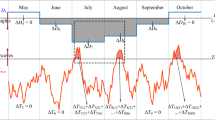Abstract
The potential direct effects of possible global warming on summer season dairy production and reproduction were evaluated for the United States and Europe. Algorithms used for milk production and conception rate were previously developed and validated. Three widely known global circulation models (GISS, GFDL, and UKMO) were used to represent possible scenarios of future climate. Milk production and conception rate declines were highest under the UKMO model scenario and lowest under the GISS model scenario. Predicted declines for the GCM scenarios are generally higher than either ‘1 year in 10’ probability-based declines or declines based on the abnormally hot summer of 1980 in the United States. The greatest declines (about 10% for the GISS and GFDL scenarios, and about 20% for the UKMO scenario) in the United States are predicted to occur in the Southeast and the Southwest. Substantial declines (up to 35%) in conception rates were also predicted in many locations, particularly the eastern and southern United States. These areas correspond to areas of high dairy cattle concentration. They already have relatively large summer season milk production declines resulting from normally hot conditions. Thus, the actual impacts of increased production declines may be greater in other areas, which are not accustomed to large summer season declines and therefore may require more extensive mitigation measures.
Similar content being viewed by others
References
Berry, I. L., Shanklin, M. D., and Johnson, H. D.: 1964, ‘Dairy Shelter Design Based on Milk Production Decline as Affected by Temperature and Humidity’, Trans of the ASAE7, 329–331.
Bosen, J. R.: 1959, Reference Data Section of Air Conditioning, Heating and Ventilating magazine.
Easterling, W. E. III, Parry, M. L., and Crosson, P. R.: 1989, ‘Adapting Future Agriculture to Changes in Climate’, in Rosenberg, N. J., Easterling, W. E., Crosson, P. R., and Darmstadter, J. (eds.),Greenhouse Warming: Abatement and Adaptation, Resources For The Future, Washington, D.C., 91 pp.
Hahn, G. L.: 1969, ‘Predicted versus Measured Production Differences Using Summer Air Conditioning For Lactating Dairy Cows’,J. Dairy Sc. 52, 800–802.
Hahn, G. L. and Osburn, D. D.: 1969, ‘Feasibility of Summer Environmental Control for Dairy Cattle Based on Expected Production Losses’, Trans. of the ASAE12, 448–551.
Hahn, G. L. and Osburn, D. D.: 1970, ‘Feasibility of Evaporative Cooling for Dairy Cattle Based on Expected Production Losses’, Trans. of the ASAE13, 289–291, 294.
Hahn, G. L. and McQuigg, J. D.: 1970, ‘Expected Production Losses for Dairy Cows as a Basis for Rational Planning of Shelters’, Intl. J. Farm Blds. Res.4, 2–8.
Hahn, G. L.: 1971, ‘Evaluation of Summer Dairy Production Environmental Modification Systems in Missouri’, Unpublished Ph.D. Dissertation, University of Missouri, Columbia, MO.
Hahn, G. L.: 1981a, ‘Use of Weather Data in the Rational Selection of Livestock Management Practices’, in Weiss, A. (ed.),Proceedings of Computer Techniques and Meteorological Data Applied to Problems of Agriculture and Forestry: A Workshop, Anaheim, CA, March 30–31, 1981, 362 pp.
Hahn, G. L.: 1981b, ‘Summer 1980 Weather Impacts on Dairy Cow Performance’, Paper presented at the 5th Biometeorology Conference of the American Meteorological Society, Anaheim, CA, April 2–3, 1981.
Hahn, G. L.: 1990, ‘Assessing the Impact of Global Climate Change on Animal Agriculture’, Paper presented at the AMS Symposium on Biometeorology and Global Change, Anaheim, CA, February 9, 1990.
Ingraham, R. H.: 1974, ‘Discussion of the Influence of Environmental Factors on Reproduction of Livestock’, inLivestock Environment I: Proceedings of the 1st International Livestock Environment Symposium, ASAE, St. Joseph, MI, pp. 55–61.
Jenne, R. L.: 1989, ‘Data from Climate Models: The CO2 Warming’, Unpublished manuscript accompanying GCM output data set, National Center for Atmospheric Research, Boulder, CO.
Jenne, R. L.: 1990, ‘Status of Selected CO2 Climate Model Runs’, Unpublished manuscript accompanying GCM output data set, National Center for Atmospheric Research, Boulder, CO.
Johnson, H. D., Hahn, G. L., and Buffington, D. E.: 1975, ‘Agricultural Implications of Climate Change: Animal Husbandry’, (Ch. 4.3), inImpacts of Climate Change on the Biosphere, National Technical Information Service, Springfield, VA.
Mearns, L. O., Katz, R. W., and Schneider, S. H.: 1984, ‘Extreme High-Temperature Events: Changes in their Probabilities with Changes in Mean Temperature’,J. Clim. Appl. Meteor. 23, 1601–1613.
Paltridge, G. (ed.): 1989, ‘Climate Impact Response Functions - Report of Workshop held at Coolfont, WV, September 11–14, 1989’, National Climate Program Office, Washington, D.C.
Smith, A. B. and Tirpak, D.: 1989, ‘The Potential Effects of Global Climate Change on the United States’, Report to Congress, U.S. Environmental Protection Agency.
Stem, E., Mertz, G. A., Stryker, J. D., and Huppi, M.: 1988, ‘Changing Animal Disease Patterns Induced by the Greenhouse Effect’, Report of a Preliminary Study to the Environmental Protection Agency, Tufts University School of Veterinary Medicine, North Grafton, MA.
Stott, G. H. and Wiersma, F.: 1976, ‘Short Term Thermal Relief for Improved Fertility in Dairy Cattle During Hot Weather’,Int. J. Biometeor. 20, 344–350.
U.S. Department of Commerce: 1989,1987 Census of Agriculture: Volume 1, Graphic Area Series; Part 1, United States Summary and State Data, DOC, Washington, D.C., pp. 232–238.
U.S. Department of Commerce: 1984,1982 Census of Agriculture: Volume 2, Subject Series; Part 1, Graphic Summary, DOC, Washington, D.C., pp. 116.
Whittemore, C. T.: 1980,Lactation of the Dairy Cow, Longman Group Ltd., London, pp. 63–75.
Yousef, M. K. (ed.): 1985,Stress Physiology in Livestock, Vol. II: Ungulates, CRC Press, Boca Raton, FL, 261 pp.
Author information
Authors and Affiliations
Additional information
Published as Paper No. 9698 Journal Series, Nebraska Agricultural Research Division. The work reported here was conducted under Nebraska Agricultural Research Division Project 27–007.
Rights and permissions
About this article
Cite this article
Klinedinst, P.L., Wilhite, D.A., Hahn, G.L. et al. The potential effects of climate change on summer season dairy cattle milk production and reproduction. Climatic Change 23, 21–36 (1993). https://doi.org/10.1007/BF01092679
Received:
Revised:
Issue Date:
DOI: https://doi.org/10.1007/BF01092679




